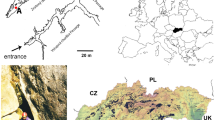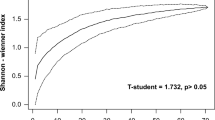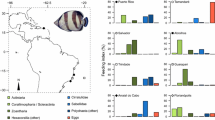Abstract
Spiders are among the most diversified and abundant predators in terrestrial ecosystems across the world, but information on their prey is limited. Particularly, there is paucity of data for prey-specialised species, such as palpimanid spiders. Here we investigated the trophic strategy of four palpimanid species (Diaphorocellus biplagiatus, Otiothops birabeni, Palpimanus gibbulus, and P. potteri) representing all three subfamilies (Chediminae, Otiothopinae, Palpimaninae) and three geographic areas (Mediterranean, South America, South Africa) in order to infer a trophic strategy for the entire family Palpimanidae. We predicted that all palpimanids are specialised araneophagous predators. We used molecular gut-content analysis, combined with comparative analysis of morphological trophic traits. We found all four species to catch spiders more than insects. All species captured spiders belonging to several families, but predominantly those of the cursorial guild. The diet composition did not differ between sexes and juveniles. The breadth of trophic niche was narrow for all species, suggesting stenophagy. Using comparative analysis of morphological traits (thick cuticle, stout forelegs, scopulae on forelegs, and stridulatory apparatus) and araneophagy, we estimated that preying on spiders combined with the morphological traits is ancestral state for the entire family. We suggest that the whole family Palpimanidae includes araneophagous species.



Similar content being viewed by others
Data availability
The data that supports the findings of this study are available from Genbank and the supplementary material of this article.
References
Aronesty, E. (2013). Comparison of sequencing utility programs. Open Bioinformatics Journal, 7(1), 1–8.
Baydizada, N., Tóthová, A., & Pekár, S. (2020). Tracing the evolution of trophic specialisation and attack behaviour in ground spider family Gnaphosidae. Organism Diversity & Evolution, 20, 551–563.
Beaulieu, J. M., O’Meara, B. C., & Donoghue, M. J. (2013). Identifying hidden rate changes in the evolution of a binary morphological character: The evolution of plant habit in campanulid angiosperms. Systematic Biology, 62(5), 725–737.
Cardoso, P., Pekár, S., Jocqué, R., & Coddington, J. A. (2011). Global patterns of guild composition and functional diversity of spiders. PloS One, 6(6), e21710.
Cerveira, A. M., & Jackson, R. R. (2005). Specialised predation by Palpimanus sp. (Araneae: Palpimanidae) on jumping spiders (Araneae: Salticidae). Journal of East African Natural History, 94(2), 303–317.
Coddington, J. A., & Levi, H. W. (1991). Systematics and evolution of spiders (Araneae). Annual Review of Ecology and Systematics, 22, 565–592.
Folmer, O., Black, M., Hoeh, W., Lutz, R., & Vrijenhoek, R. (1994). DNA primers for amplification of mitochondrial cytochrome c oxidase subunit I from diverse metazoan invertebrates. Molecular Marine Biology and Biotechnology, 3(5), 294–299.
Forster, R. R., & Platnick, N. I. (1984). A review of the archaeid spiders and their relatives, with notes on the limits of the superfamily Palpimanoidea (Arachnida, Araneae). Bulletin of the American Museum of Natural History, 178, 1–106.
Gajski, D., Petráková, L., & Pekár, S. (2020). Ant-eating predator maintains specialist diet throughout its ontogeny. Journal of Zoology, 311(3), 155–163.
García, L. F., Viera, C., & Pekár, S. (2018). Comparison of the capture efficiency, prey processing, and nutrient extraction in a generalist and a specialist spider predator. Science of Nature, 105, 30.
Goloboff, P. A. (2000). The family Gallieniellidae (Araneae, Gnaphosidae) in the Americas. Journal of Arachnology, 28(1), 1–6.
Grafen, A. (1989). The phylogenetic regression. Philosophical Transactions of the Royal Society of London, Series b, Biological Sciences, 326, 119–157.
de Groot, A. G., Laros, I., & Geisen, S. (2016). Molecular identification of soil eukaryotes and focused approaches targeting protist and faunal groups using high-throughput meta-barcoding. Methods in Molecular Biology, 1399, 125–140.
Haddad, C. R. (2016). Diversity and ecology of spider assemblages associated with Vachellia xanthophloea bark in a South African reserve (Arachnida: Araneae). African Entomology, 24, 321–333.
Henschel, J. R. (1997). Psammophily in Namib desert spiders. Journal of Arid Environment, 37, 695–707.
Hurlbert, S. H. (1978). The measurement of niche overlap and some relatives. Ecology, 59(1), 67–77.
Jézéquel, J. F. (1964). Araignées de la savane de Singrobo (Côte d’Ivoire). II. — Palpimanidae et Zodariidae. Bulletin du Muséum National d’Histoire Naturelle de Paris, 36(3), 326–338.
Jocqué, R. (1991). A generic revision of the spider family Zodariidae (Araneae). Bulletin of the American Museum of Natural History, 201(1), 1–160.
Kloock, C. T. (2001). Diet and insectivory in the “araneophagic” spider, Mimetus notius (Araneae: Mimetidae). American Midland Naturalist, 146, 424–428.
Larsen, N. (2012). Predatory behaviour of Afrotropical Palpimanidae. Newsletter of the African Arachnological Society, 25, 9.
Lawrence, R. F. (1938). Transvaal museum expedition to South-West Africa and Little Namaqualand, May to August 1937. Spiders. Annals of the Transvaal Museum, 19, 215–226.
Lehtinen, P. T. (1982). Spiders of the Oriental-Australian region. IV. Stenochilidae. Annales Zoologici Fennici, 19, 115–128.
Li, D., Jackson, R. R., & Barrion, A. (1997). Prey preferences of Portia labiata, P. africana, and P. schultzi, araneophagic jumping spiders (Araneae: Salticidae) from the Philippines, Sri Lanka, Kenya, and Uganda. New Zealand Journal of Zoology, 24(4), 333–349.
Líznarová, E., & Pekár, S. (2019). Trophic niche and capture efficacy of an ant-eating spider, Euryopis episinoides (Araneae: Theridiidae). Journal of Arachnology, 47(1), 45–51.
Líznarová, E., Sentenská, L., Šťáhlavský, F., & Pekár, S. (2018). Stridulation can suppress cannibalism in a specialised araneophagous predator. Behavioral Ecology and Sociobiology, 72(8), 127.
Mahé, F., Rognes, T., Quince, C., de Vargas, C., & Dunthorn, M. (2014). Swarm: Robust and fast clustering method for amplicon-based studies. PeerJ, 2, e593.
Martin, M. (2011). Cutadapt removes adapter sequences from high-throughput sequencing reads. Embnet Journal, 17(1), 10–12.
Marusik, Y. M., & Zonstein, S. L. (2018). Notes on the spider genus Steriphopus (Araneae: Palpimanidae), with redescription of the type species. Arachnology, 17(9), 491–496.
Michálek, O., Kuhn-Nentwig, L., & Pekár, S. (2019a). High specific efficiency of venom of two prey-specialized spiders. Toxins, 11(12), 687.
Michálek, O., Haddad, C., & Pekár, S. (2021). Fundamental trophic niche of two prey-specialised jumping spiders, Cyrba algerina and Heliophanus termitophagus (Araneae: Salticidae). Journal of Arachnology, 49(2), 268–271.
Michálek, O., Řezáč, M., Líznarová, E., Symondson, W. O. C., & Pekár, S. (2019b). Silk versus venom: Alternative capture strategies employed by closely related myrmecophagous spiders. Biological Journal of the Linnean Society, 126(3), 545–554.
Moran, N. A. (1988). The evolution of host-plant alteration in aphids: Evidence for specialization as a dead end. American Naturalist, 132, 681–706.
Novakowski, G. C., Hahn, N. S., & Fugi, R. (2008). Diet seasonality and food overlap of the fish assemblage in a pantanal pond. Neotropical Ichthyology, 6(4), 567–576.
Oketch, A. D., Zonstein, S., Kioko, E. N., & Li, S. Q. (2020). Description of a new genus and three new species of the family Palpimanidae (Arachnida, Araneae) from Kenya. African Invertebrates, 61(2), 93–106.
Pekár, S. (2004). Predatory behavior of two European ant-eating spiders (Araneae, Zodariidae). Journal of Arachnology, 32(1), 31–41.
Pekár, S., & Brabec, M. (2016). Modern analysis of biological data. Generalized Linear Models in R. Masaryk University, Brno.
Pekár, S., & Toft, S. (2015). Trophic specialisation in a predatory group: The case of prey-specialised spiders (Araneae). Biological Reviews, 90(3), 744–761.
Pekár, S., Král, J., & Lubin, Y. D. (2005). Natural history and karyotype of some ant-eating zodariid spiders (Araneae, Zodariidae) from Israel. Journal of Arachnology, 33, 50–62.
Pekár, S., Šobotník, J., & Lubin, Y. (2011). Armoured spiderman: Morphological and behavioural adaptations of a specialised araneophagous predator (Araneae: Palpimanidae). Naturwissenschaften, 98(7), 593–603.
Pekár, S., Coddington, J. A., & Blackledge, T. (2012a). Evolution of stenophagy in spiders (Araneae): Evidence based on the comparative analysis of spider diets. Evolution, 66(3), 776–806.
Pekár, S., Šmerda, J., Hrušková, M., Šedo, O., Muster, C., Cardoso, P., Zdráhal, Z., Korenko, S., Bureš, P., Líznarová, E., & Sentenská, L. (2012b). Prey-race drives differentiation of biotypes in ant-eating spiders. Journal of Animal Ecology, 81(4), 838–848.
Pekár, S., Michalko, R., Korenko, S., Šedo, O., Líznarová, E., Sentenská, L., & Zdráhal, Z. (2013). Phenotypic integration in a series of trophic traits: Tracing the evolution of myrmecophagy in spiders (Araneae). Zoology, 116(1), 27–35.
Pekár, S., Šedo, O., Líznarová, E., Korenko, S., & Zdráhal, Z. (2014). David and Goliath: Potent venom of an ant-eating spider (Araneae) enables capture of a giant prey. Naturwissenschaften, 101(7), 533–540.
Pekár, S., Líznarová, E., Bočánek, O., & Zdráhal, Z. (2018a). Venom of prey-specialized spiders is more toxic to their preferred prey: A result of prey-specific toxins. Journal of Animal Ecology, 87(6), 1639–1652.
Pekár, S., Petráková, L., Šedo, O., Korenko, S., & Zdráhal, Z. (2018b). Trophic niche, capture efficiency, and venom profiles of six sympatric ant-eating spider species (Araneae: Zodariidae). Molecular Ecology, 27(4), 1053–1064.
Pekár, S., Petráková Dušátková, L., Michálek, O., & Haddad, C. R. (2020). Coexistence of two termite-eating specialists (Araneae). Ecological Entomology, 45(6), 1307–1317.
Petráková Dušátková, L., Pekár, S., Michálek, O., Líznarová, E., & Symondson, W. O. C. (2020). Estimation of trophic niches in myrmecophagous spider predators. Scientific Reports, 10, 8683.
Platnick, N. I. (1975). A revision of the palpimanid spiders of the new subfamily Otiothopinae (Araneae, Palpimanidae). American Museum Novitates, 2562, 1–32.
Platnick, N. I. (1981). A review of the spider subfamily Palpimaninae (Araneae, Palpimanidae), I. Bulletin of the British Arachnological Society, 5(4), 169–173.
Platnick, N. I., Grismado, C. J., & Ramírez, M. J. (1999). On the genera of the spider subfamily Otiothopinae (Araneae, Palpimanidae). American Museum Novitates, 3257, 1–25.
Pompozzi, G., García, L. F., Petráková, L., & Pekár, S. (2019). Distinct feeding strategies of generalist and specialist spiders. Ecological Entomology, 44(1), 129–139.
R Core Team. (2017). R: A language and environment for statistical computing. R Foundation for Statistical Computing, Vienna, Austria. https://www.R-project.org/.
Rodríguez-Pena, E., Verísimo, P., Fernández, L., González-Tizón, A., Bárcena, C., Martínez-Lage, A. (2020). High incidence of heteroplasmy in the mtDNA of a natural population of the spider crab Maja brachydactyla. PLoS One, 15(3), e0230243.
Řezáč, M., Pekár, S., Arnedo, M., Macías-Hernández, N., & Řezáčová, V. (2021). 1. Evolutionary insights into the eco-phenotypic diversification of Dysdera spiders in the Canary Islands. Organisms Diversity & Evolution, 21, 79–92.
Sheppard, S. K., Bell, J., Sunderland, K. D., Fenlon, J., Skervin, D., & Symondson, W. O. C. (2005). Detection of secondary predation by PCR analyses of the gut contents of invertebrate generalist predators. Molecular Ecology, 14(14), 4461–4468.
Wood, H. M., & Scharff, N. (2018). A review of the Madagascan pelican spiders of the genera Eriauchenius O. Pickard-Cambridge, 1881 and Madagascarchaea gen. n. (Araneae, Archaeidae). ZooKeys, 727, 1–96.
Wood, H. M., Griswold, C. E., & Gillespie, R. G. (2012). Phylogenetic placement of pelican spiders (Archaeidae, Araneae), with insight into evolution of the “neck” and predatory behaviours of the superfamily Palpimanoidea. Cladistics, 28(6), 598–626.
Wood, H. M., González, V. L., Lloyd, M., Coddington, J., & Scharff, N. (2018). Next-generation museum genomics: Phylogenetic relationships among palpimanoid spiders using sequence capture techniques (Araneae: Palpimanoidea). Molecular Phylogenetics and Evolution, 127, 907–918.
World Spider Catalog. (2020). World Spider Catalog. Version 21.5. Natural History Museum Bern, online at http://wsc.nmbe.ch, accessed on November 3rd, 2020. 10.24436/2
Zonstein, S., & Marusik, Y. M. (2013). On Levymanus, a remarkable new spider genus from Israel, with notes on the Chediminae (Araneae, Palpimanidae). ZooKeys, 326, 27–45.
Zonstein, S. L., & Marusik, Y. M. (2017a). Descriptions of the two-eyed African spider genera Chedimanops gen. n. and Hybosidella gen. n. (Araneae, Palpimanidae, Chediminae). African Invertebrates, 58(1), 23–47.
Zonstein, S. L., & Marusik, Y. M. (2017b). A redescription of Chedima purpurea Simon, 1873, with notes on the unique copulative stopper mechanism in females (Aranei: Palpimanidae). Arthropoda Selecta, 26(3), 225–232.
Zonstein, S. L., & Marusik, Y. M. (2020). A review of the spider genus Boagrius Simon, 1893 (Araneae: Palpimanidae). Raffles Bulletin of Zoology, 68, 91–102.
Zonstein, S. L., Marusik, Y. M., & Kovblyuk, M. M. (2017). New data on the spider genus Levymanus (Araneae: Palpimanidae). Oriental Insects, 51(3), 221–226.
Zonstein, S. L., Marusik, Y. M., & Omelko, M. M. (2016). Redescription of the type species of Diaphorocellus Simon, 1893 (Araneae, Palpimanidae, Chediminae). African Invertebrates, 57(2), 93–103.
Zonstein, S. L., Marusik, Y. M., & Omelko, M. M. (2018). Redescription of the monotypic genus Scelidomachus Pocock, 1899 (Aranei: Palpimanidae) and its type species. Arthropoda Selecta, 27(1), 53–56.
Acknowledgements
We would like to thank S. Korenko, M. Forman, and P. Just for collecting spiders in Portugal or Italy, and R. Booysen, J. A. Neethling, E. Liznarová, and O. Michálek for assisting with field work in South Africa. Fieldwork at Ndumo Game Reserve and Bankfontein was carried out under Ezemvelo KZN Wildlife permit numbers OP 552/2015, OP 4072/2016, and OP 1869/2018, and permit numbers NC.614/2017 and 201911000003852 from the Free State Department of Economic, Small Business Development, Tourism and Environmental Affairs, respectively. South African field work was funded through a Research Development Grant from the National Research Foundation of South Africa (#112127). We acknowledge the CF Genomics of CEITEC supported by the NCMG research infrastructure (LM2018132 funded by MEYS CR) for their support in obtaining the scientific data presented in this paper.
Author information
Authors and Affiliations
Contributions
SP conceived and designed the study; CRH, SP, and LFG collected the spiders in the field; LP, TM, and OS did the gut content analysis; SP analysed the data; all authors drafted the manuscript and gave final approval for publication.
Corresponding author
Additional information
Publisher's Note
Springer Nature remains neutral with regard to jurisdictional claims in published maps and institutional affiliations.
Supplementary information
Below is the link to the electronic supplementary material.
Rights and permissions
About this article
Cite this article
Pekár, S., Dušátková, L.P., Macháčková, T. et al. Gut-content analysis in four species, combined with comparative analysis of trophic traits, suggests an araneophagous habit for the entire family Palpimanidae (Araneae). Org Divers Evol 22, 265–274 (2022). https://doi.org/10.1007/s13127-021-00525-9
Received:
Accepted:
Published:
Issue Date:
DOI: https://doi.org/10.1007/s13127-021-00525-9




